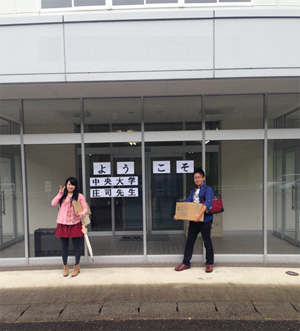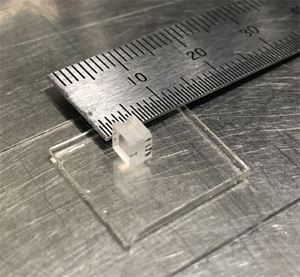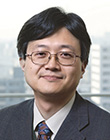Top>Research>Joint Research with Corporations through the JST Regional Industry-Academia Value Program
Joint Research with Corporations through the JST Regional Industry-Academia Value Program
Ichiro Shoji
Professor, Faculty of Science and Engineering, Chuo University
Areas of Specialization: Lasers, Nonlinear Optics
Introduction
For the one-year period from October 2017 to September 2018, my research was selected for the Regional Industry-Academia Value Program, an open-application program operated by the Japan Science and Technology Agency (JST). During this one-year period, I conducted joint research with a corporation. In this article, I would like to introduce the background leading up to selection, details of the research project, and information on future initiatives. I will also discuss positive aspects of the research, as well as points requiring improvement.
What is the Regional Industry-Academia Value Program?
This program supports experimental research for confirming whether or not the results (seeds) obtained from university research activities will be helpful to the technology and expertise (needs) required by corporations when developing products. A specialist known as a “Matching Planner” meets with both the university and corporation in order to make an objective judgment on whether the university seeds will truly contribute to corporate needs. The Matching Planner also serves as a bridge to ensure smooth implementation of the project. The program seeks to put the initial stage of industry-academia joint research on the right track, to create core technology for corporations, to advance projects into full-scale joint research, and to implement projects which will have economic/social ripple effects.
Details of the Regional Industry-Academia Value Program are available on the JST website: https://www.jst.go.jp/mp/koubo.html (from fiscal 2018, the name of the program has been changed to “Adaptable and Seamless Technology Transfer Program through Target-driven R&D (A-STEP) Function Verification Phase”).
Background until applying for the program
The research results serving as seeds in my research project are a device that emits ultraviolet light by converting the wavelength of lasers. There are limited types of laser materials and each type emits a certain wavelength. Therefore, when a material capable of emitting the required wavelength is not available, researchers use technology to convert the wavelength of lasers. Specifically, when a laser beam passes through the wavelength conversion device, the laser emitted from the device has a wavelength differing from the original laser. In order to emit a wavelength-converted laser with output at a level appropriate for practical use, it is necessary to optimize factors such as the type of material used in the device, the orientation, and structure of the device. My research group has developed a device which employs a unique method known as room-temperature bonding to affix a material called BBO on the atomic level while changing among multiple orientations. Through this technology, we succeeded in emitting an ultraviolet laser with high output power that is nearly twice that of conventional devices. I introduce this research in a ChuoOnline article (https://www.yomiuri.co.jp/adv/chuo/dy/research/20110825.html) published in 2011; I encourage you to read this article if you are interested in more information.

▲Figure 1: Photograph taken when visiting Company A’s factory in the Tohoku region
Upon learning of the device through a TLO introducing the research results of Chuo University, Company A contacted us regarding possible use of the device in the development of next-generation products. Ultimately, Company A cooperated with our research group to conduct joint research in the Regional Industry-Academia Value Program. Despite having less than 100 employees, Company A is well-known in the laser industry as possessing the world’s top share in the manufacturing of ultraviolet laser equipment used for purposes such as inspecting semiconductors. Although existing products at Company A use gas as the laser material, the company is considering switching to a solid-state material which is more compact and has a longer lifespan. By making this change, Company A seeks to increase its ability to compete internationally. This technology requires wavelength conversion from a solid-state laser emitting red light to an ultraviolet light. However, Company A was having trouble due to the inability to obtain enough output power when using conventional BBO.
The situation described above took place in the summer of 2015. From that time, my research group started joint research with Company A. Although the company’s head office is located in Tokyo, the factory where laser equipment is manufactured is located in the Tohoku region. Therefore, I sometimes went with students from my laboratory to conduct preparatory experiments at that factory (Figure 1). I remember feeling a deep sense of gratitude upon seeing my name displayed on the front doors of the factory as a welcome sign.
However, the devices which we had been manufacturing at our laboratory at that time used a different wavelength. Consequently, a significant amount of fund was required in order to purchase a new material and process that material for use in the device. This prevented us from beginning full-scale research for the device. At that time, a Research Administrator (URA) at Chuo University introduced the Regional Industry-Academia Value Program to our research group. Upon realizing that the purpose of the program matched the intention of our research, we decided to apply. I received outstanding support from the URA and staffs of the Research Promotion Office in all phases of application, from arranging meetings with the Matching Planner to creating the application material. Thanks to this support, our research was selected for the program. I would like to take this opportunity to express my sincere gratitude to everyone involved in the project.
Research conducted after being selected for the program

▲Figure 2: Prototype device with an unacceptably large error in the cutting angle
The initial plan called for manufacturing of an initial prototype device to be completed and for evaluation experiments to be conducted at Company A around January 2018. However, we encountered several technological issues while attempting to manufacture a prototype. One issue was related to material processing prior to device manufacturing. In order to achieve appropriate output for the emitted ultraviolet light, it was necessary to cut the material precisely at an angle of 0.1º. Although we outsourced this cutting work to fabrication specialists, the majority of them were unable to achieve the required precision. This made it necessary to revise the process from scratch. Figure 2 shows a device manufactured prior to resolving this issue.
Another issue was related to the orientation of crystals prior to cutting the material. When cutting sections from two or more base materials, we realized that it was necessary to ascertain the original orientation relationship of the base materials in advance. Failure to do so makes it impossible to achieve the desired output.
Identifying the causes of these issues and formulating countermeasures took a great amount of time. In the blink of an eye, we had already spent one year working on the research. The knowledge gained during these processes had academic value and we were able to give presentations at an academic conference. Unfortunately, we were unable to manufacture a device capable of evaluating whether or not there is an appropriate level of performance that was achieved by Company A’s products.
On completion of the research period—the importance of industry-academia cooperation
The research period ended in September 2018. Fortunately, Company A patiently waited for the completion of a device suitable for use in evaluation. Currently, we are using revised processes while working at a feverish pitch to prepare for device manufacturing. Until now, our group used a research style in which we took our time and thoroughly investigated each aspect of our work. However, in the current research project, the company specified a certain date by which they wanted to create prototype equipment and we were required to manufacture an appropriate device by that time. Working in this style made me once again realize the difference in the speed of research at universities and corporations.
At universities, a certain laboratory is responsible for a wide range of work spanning from fundamental subjects to practical application. This is also true for my research laboratory. Particularly in the case of research aimed at practical implementation, failure to seek practical application through joint research with a corporation or other users will render the research meaningless. Accordingly, in addition to useful technology serving as seeds, I once again felt the need of an ability to “get things done”—specifically, to meet the expectations of corporations. While working to guide this research project to success and achieve a commercially viable product, I will also continually strive to contribute to society by actively engaging in industry-academia partnerships in the future.
- Ichiro Shoji
Professor, Faculty of Science and Engineering, Chuo University
Areas of Specialization: Lasers, Nonlinear Optics - Ichiro Shoji was born in Muroran City in Hokkaido in 1969. He graduated from the Department of Applied Physics in the Faculty of Engineering, the University of Tokyo, in 1992. In 1994, he completed the Master’s Program of the Department of Applied Physics in the Graduate School of Engineering, the University of Tokyo. In 1995, he withdrew the Doctoral Course of the Department of Applied Physics in the Graduate School of Engineering, the University of Tokyo.
He holds PhD in engineering (the University of Tokyo).
After serving as a research associate at the University of Tokyo and the Institute for Molecular Science, he obtained a position at Chuo University in 2004. He served there as Full-time Assistant Professor and Associate Professor before assuming his current position in 2010.
He is currently engaged in characterization of laser materials and the research and development of high-performance compact solid-state lasers, using technology he has developed himself.
- Research Activities as a Member of Research Fellowship for Young Scientists (DC1), Japan Society for the Promotion of Science (JSPS) Shuma Tsurumi
- Important Factors for Innovation in Payment Services Nobuhiko Sugiura
- Beyond the Concepts of Fellow Citizens and Foreigners— To Achieve SDGs Goal 10 “Reduce Inequality Within and Among Countries” Rika Lee
- Diary of Struggles in Cambodia Fumie Fukuoka
- How Can We Measure Learning Ability?
—Analysis of a Competency Self-Assessment Questionnaire— Yu Saito / Yoko Neha - The Making of the Movie Kirakira Megane

-
Newest Edition 2019 Autumn Issue
Student journalists report on the students’ take of Chuo University

-
Chuo-DNA
The school's history and motto have been passed on to graduates and students alike. Here is a visualization of Chuo University in the future.Core Energy
Launching Chuo University's Knowledge into Action to the rest of the world, like an infinity of sparkling stars scattered throughout space.
Planned by The Yomiuri Shimbun Business Bureau [PR]















